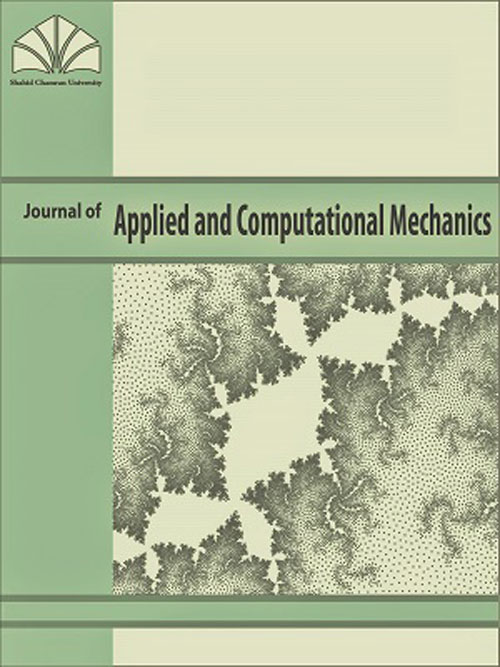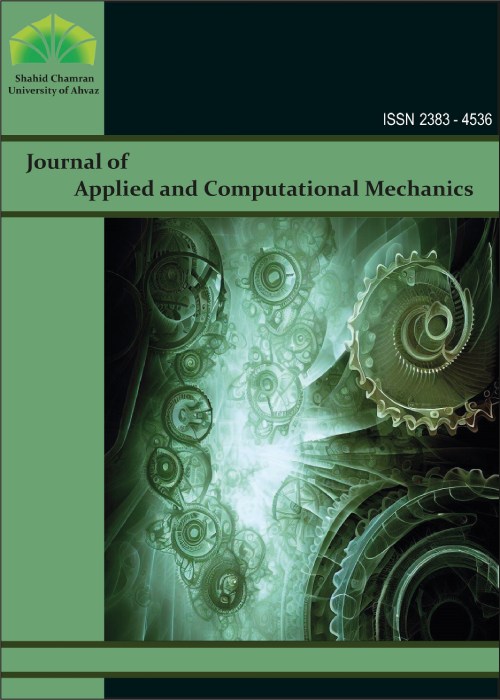فهرست مطالب

Journal of Applied and Computational Mechanics
Volume:3 Issue: 2, Spring 2017
- تاریخ انتشار: 1396/02/30
- تعداد عناوین: 7
-
-
Pages 92-102In this paper, the shape influence of piezoelectric beams including triangle, trapezoid, rectangle, inverted trapezoid, convex parabola, concave parabola, and comb-shaped (a combination of two triangular beams with a connector of 4 mm length) are addressed and analyzed by FEM. The analysis is performed for a bimorph piezoelectric beam. The analyzed parameters include the beam length, thickness and width of the piezoelectric layer. The study is performed using COMSOL Multiphysics software for all seven shapes. The results show that due to the mechanical properties of the beams, the natural frequency of the triangular beam is more for all considered parameters. In addition, as the width of the beam end increases, the natural frequency reduces, too. Since natural frequency is inversely related to electric power, the inverted trapezoidal beam has the highest electric power and the triangular beam has the lowest one.Keywords: Piezoelectric beam, Bimorph, Geometry, Finite element
-
Pages 103-113In this paper, the flow, thermal and concentration analyses of blood as a third grade with gold as nanoparticles through a porous channel are carried out using regular perturbation method. The analysis are carried out using Vogels model of temperature-dependent viscosity. The developed models were used to investigate the effects of the nano particles on the concentration, temperature and velocity of the fluid as it flows through the porous medium of a hollow channel in the presence of magnetic field. Also, the effects of fluid parameters such as Brownian motion, thermophoresis, viscous dissipation, non-Newtonian, porosity, magnetohydrodynamics (MHD), diffusion constant at various values on the fluid were established. The results generated in this work were found to be in good agreement with the results found in litereture.Keywords: Perturbation solutions, Magnetohydrodynamics, Blood, Third grade, Nanofluid
-
Pages 114-124In this work, effects of different tool pin profiles of flat and tapered shoulder geometries on the peak temperature in friction stir welding are investigated analytically. The developed models used for the analytical investigations considered the welding process as a combination or mixture of the pure sliding and the pure sticking. From the results, the amount of heat generation and the peak temperature are directly proportional to the number of edges in the pin profiles in such a way that the heat generated and peak temperature in the profiles increases from the triangular pin profile to hexagonal pin profile. Also, the rate of heat generation and the peak temperature in flat shoulder are greater than in tapered/conical shoulder. The results in this work are validated with experimental and the past theoretical results and good agreements are achieved.Keywords: Frictional stir welding, Peak temperature, Different tool pin Profiles, Analytical investigations
-
Pages 125-134The Casimir attraction can significantly interfere the physical response of nanoactuators. The intensity of the Casimir force depends on the geometries of interacting bodies. The present paper is dedicated to model the influence of the Casimir attraction on the electrostatic stability of nanoactuators made of cylindrical conductive nanowire/nanotube. An asymptotic solution, based on path-integral approach, is employed to consider the Casimir force. The continuum theory is employed to derive the constitutive equation of the actuator. The governing nonlinear equations are solved by three different approaches. Various perspectives of the issue including comparison with the van der Waals (vdW) force regime, the variation of instability parameters and effect of geometry are addressed.Keywords: Nanowire, Nanotube fabricated actuator, Casimir attraction, Continuum model, Generalized Differential Quadrature (GDQ), Modified Variation Iteration Method (MVIM)
-
Pages 135-143In this paper, the dynamic response of resonating nano-beams is investigated using a strain gradient elasticity theory. A nonlinear model is obtained based on the Galerkin decomposition method to find the dynamic response of the investigated beam around its statically deflected position. The mid-plane stretching, axial residual stress and nonlinear interaction due to the electrostatic force on the deflected beam are included in the proposed nonlinear beam model. Comparing the beam natural frequency using strain gradient theory with experimental data shows an excellent agreement among both approaches. The normalized natural frequency is shown to be increasing nonlinearly with the decrease of the applied DC voltage as well as beam thickness. The results also reveal that increasing the tension axial stress increases the natural frequency; however its influence decreases when decreasing the beam thickness. To investigate the effect of AC actuation voltage on the beam resonant frequency, a Lindstedt-Poincare based perturbation method is utilized and validated by comparison with experimental data. The results show that increasing the AC actuation voltage makes the beam stiffer by increasing its resonant frequency.Keywords: NEMS, Nano, resonator, Strain gradient elasticity theory, Size effect
-
Pages 144-149Image segmentation is a fundamental approach in the field of image processing and based on users application .This paper propose an original and simple segmentation strategy based on the EM approach that resolves many informatics problems about hyperspectral images which are observed by airborne sensors. In a first step, to simplify the input color textured image into a color image without texture. The final segmentation is simply achieved by a spatially color segmentation using feature vector with the set of color values contained around the pixel to be classified with some mathematical equations. The spatial constraint allows taking into account the inherent spatial relationships of any image and its color. This approach provides effective PSNR for the segmented image. These results have the better performance as the segmented images are compared with Watershed & Region Growing Algorithm and provide effective segmentation for the Spectral Images & Medical Images.Keywords: Segmentation, Hyperspectral, EM
-
Pages 150-157Today, due to the natural decline of oil exploitation, the use of methods of oil recovery, has made significant progress. However, these methods are accompanied by accumulation and deposition of mineral deposits in oil field installations. In the present study, aqueous solutions, strontium sulfate, barium sulfate, manganese sulfate and nickel sulfate are studied, in terms of EUNIQUAC model and genetic algorithms. Based on the findings of this article, as temperature increases, in order to increase the solubility of the system, the ionic strength decreases; but with increasing pressure, the solubility of barium sulfate increases. Meanwhile, in this article, to evaluate water activity, aqueous solutions of manganese sulfate and nickel sulfate is studied.Keywords: Mineral Ions, Ionic Strength, Water Activity, EUNIQUAC Model


